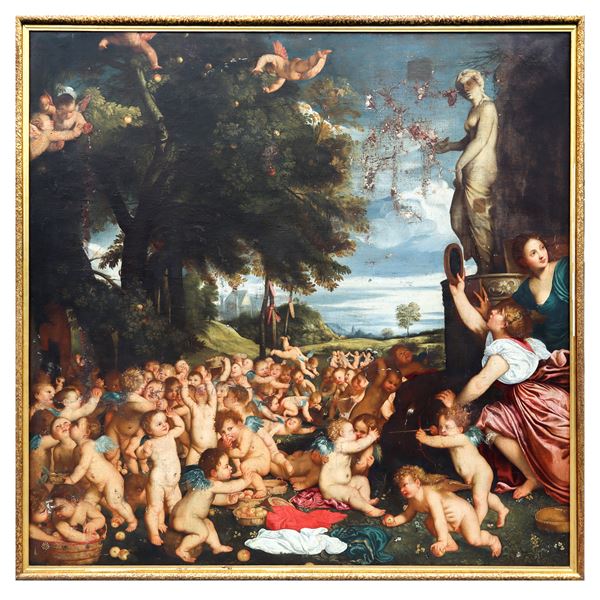Fabrizio Chiari © (1615 ca, 1695)
Triumph of Venus, XVI Century
Expertise by Professor Claudio Strinati: "The painting depicting the so-called Homage to Venus (oil on canvas, cm . < /span>171 x 176 ) and a copy of the highest quality and in fair condition of conservation of the famous painting by Tiziano Vecellio (currentlypreserved at the Prado Museum in Madrid) known abantiquo col title of the Feast of Cupids (as it is still sometimes cited today) and with
< o:p>
the more famous one, Homage to Venus.
Titian painted it for Alfonso's alabaster dressing rooms |d' Este lord of Ferrara. He had prepared it in the Ducal Palace of his city a sort of wonderful studio to decorate which I invite some of greatest Italian painters active in his time, that is, at the beginning of the sixteenth century.
And among these Titian obviously stood out for his incomparable fame and intrinsic greatness. The Homage to Venus was a resounding success, so much so that it has become one of the most loved paintings by the artists themselves and by critics of art so much so be copied by many of Europe's most distinguished painters among the sixteenth and seventeenth centuries like Rubens, Reni, Poussin!< /span>
Our copy, here in question, probably dates back to the same period historical in the midst of the “neo-Venetian” phase, as RobertoLonghi calls it in his studies on the Este court and its enormous influence. So our copycould be dated about a hundred years later or a little more than the original Titian executed around 1520, and refer to the Roman environment that he had a true cult towards the magnificence of Venetian artwhen, in the eternal city, I dominate the great painter and architect Pietro da Cortona who, although Tuscan, was a very devoted follower of the Venetian mastersof the sixteenth century. Among the many students and collaborators of Cortona who were devoted with particular commitment to increasing with their works this fascinating Venetian taste in Rome, I believe is possible identify the author of our copy.
Evaluating the pictorial material of our copy and excellent quality of drawing and what we could call a real reinterpretation of the Titian style, I believe that to execute the painting hereunder examination was a very specific follower of Cortona.This is the Roman master Fabrizio Chiari (1615ca.-1695), an artist highly praised in his time, learned classicist and lover of Venetian taste as can be seen in one of his masterpieces, the immense and beautiful fresco depicting the Reconciliation of Jacob and Esau in the so-called Galleryof Alexander VII at the Quirinale, executed in the 1650s.
It seems to me here to recognize in it the same hand that executed the magnificent copy here in question, of marked naturalistic taste, very fine quality of pictorial and drawing material, purely seventeenth-century.A painting, ultimately, of notable historical-artistic interest and excellent quality.
</ p>
Yours faithfully, Claudio Strinati"
The work is accompanied by a study on pigments carried out by the professor's nuclear physics faculty Paolo Romano, of the University of Catania, who certifies the nature of the pigments.












